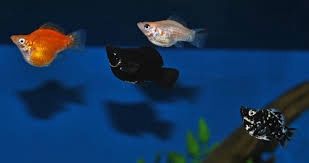Balloon Molly
Balloon Mollies are a selectively bred variant of the common molly (Poecilia latipinna or Poecilia sphenops), characterized by their rounded, balloon-like bellies and compact bodies. While they are peaceful, colorful, and popular in aquariums, they require some specific care due to their unique body shape and slightly more delicate health.
Balloon Molly – Complete Care Guide
Quick Facts
-
Scientific name: Poecilia sphenops (variant)
-
Common names: Balloon Molly, Balloon Belly Molly
-
Size: 2–3 inches (5–7.5 cm)
-
Lifespan: 2–4 years (shorter than standard mollies)
-
Temperament: Peaceful, social
-
Care level: Moderate (due to body structure)
-
Tank level: Mid to top swimmers
-
Origin: Captive-bred
Tank Requirements
| Parameter | Ideal Range |
|---|---|
| Tank size: | 20 gallons+ (larger for groups) |
| Temperature: | 24–28°C (75–82°F) |
| pH: | 7.0–8.5 (prefer alkaline) |
| Hardness: | Medium to hard water |
| Salinity: | Tolerant of brackish water (optional) |
| Water flow: | Moderate |
| Lighting: | Standard LED or natural lighting |
| Substrate: | Sand or gravel |
| Decor: | Plants, rocks, caves for cover |
Tip: Use a secure lid — mollies may jump.
Water Quality
-
Regular water changes (25–30% weekly)
-
Maintain good filtration to prevent ammonia/nitrite spikes
-
Slightly alkaline, harder water is ideal for balloon mollies
Behavior & Tankmates
-
Social fish — best kept in groups of 3–6+
-
Compatible with:
-
Guppies, Platies, Swordtails
-
Corydoras
-
Tetras (peaceful types)
-
Shrimp (if mollies are well-fed)
-
-
Avoid:
-
Fin-nippers (e.g., tiger barbs)
-
Aggressive or large predatory fish
-
️ Diet
-
Omnivores
-
Feed a variety for color and health:
-
High-quality flake or pellet food (base diet)
-
Blanched vegetables (zucchini, spinach)
-
Algae wafers
-
Frozen or live foods (daphnia, bloodworms, brine shrimp)
-
⚠️ Don’t overfeed — balloon mollies are prone to constipation due to body shape.
Special Considerations for Balloon Mollies
| Risk | Reason | Prevention |
|---|---|---|
| Swim bladder issues | Due to compact body shape | Feed easily digestible foods, avoid overfeeding |
| Shorter lifespan | Genetic deformity from selective breeding | Provide optimal care and water conditions |
| Spinal deformities | Inherent to balloon variety | Unavoidable — choose healthy specimens |
Breeding
-
Livebearers (give birth to live fry)
-
Breed readily in groups with a ratio of 1 male to 2–3 females
-
Provide plants or hiding spots for fry
-
Adults may eat babies — use a breeding box or separate nursery tank
✅ Summary
| Category | Details |
|---|---|
| Size | 2–3 inches |
| Lifespan | 2–4 years |
| Temperament | Peaceful, social |
| Water Temp | 24–28°C (75–82°F) |
| pH | 7.0–8.5 |
| Water Hardness | Medium–hard |
| Tankmates | Peaceful community fish |
| Diet | Omnivorous |

